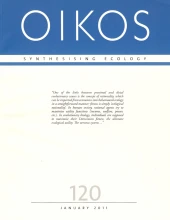By comparing fish communities with bird communities Kirsten Nash an co-workers assess the appropriateness of different size distribution indices used in a variety of studies. The analyses resulted in the Oikos Early View paper “Habitat structure and body size distributions: cross-ecosystem comparison for taxa with determinate and indeterminate growth”. Below is the author’s own summary of the paper:
How the study arose:
The study resulted from conversations at the working group ‘Understanding and managing for resilience in the face of global change’, hosted and funded by the USGS Powell Centre for Analysis and Synthesis in Fort Collins, Colorado (https://powellcenter.usgs.gov/). The working group came about through a chance meeting between myself and one of the other authors of our study (Shana Sundstrom) at the 2011 Resilience Conference in Arizona. We were both starting our PhDs addressing similar questions but in different ecosystems: Shana primarily focuses on birds, whereas my research looks at coral reef fish communities. Participants in the working group come from Canada, USA, Sweden, South Africa and Australia.

Photo of the ‘Managing for resilience’ working group at the USGS Powell Centre in Fort Collins, Colorado:
Description of our group’s focus and short summary of the paper:
An ecosystem can be in a number of different forms or states, such as a reef covered in many corals vs. a reef with large areas of thick algae and little coral. The ability of an ecosystem to remain within its initial form (e.g. coral reef) when impacted by disturbances resulting from rapid global change, rather than shift to another state (e.g. algae reef), is called the resilience of the ecosystem. Until recently, a lot of the work that has looked at the resilience of ecosystems has been theoretical. Our working group focuses on putting this theory into more practical terms, i.e. understanding how likely is it that the ecosystem will remain in its current form over time, as this directly affects natural resources on which we rely for food, water, etc.
An important step in this process was to take methods that had initially been developed to look at terrestrial taxa, and explore their appropriateness for marine systems, to ensure that our work was relevant across a range of ecosystems and wasn’t limited to terrestrial studies. The result was our study recently published in Oikos, where we compare the ability of different animal size measurements to highlight the effect of a variety of habitats on the bird and fish communities that live within them. We completed fieldwork on fish communities inhabiting reefs of the Great Barrier Reef and the Seychelles and used published data for bird communities in Borneo (Cleary et al., 2007, Ecological Applications) and the Lofty Ranges, Australia (courtesy of Hugh Possingham and the Nature Conservation Society of South Australia). The study shows that both average and individual size measurements are useful for showing the effect of habitat on bird communities. In contrast, for fishes, we need to incorporate the size measurements of all individuals within a community to show the effects of habitat on fishes.


Leave a comment